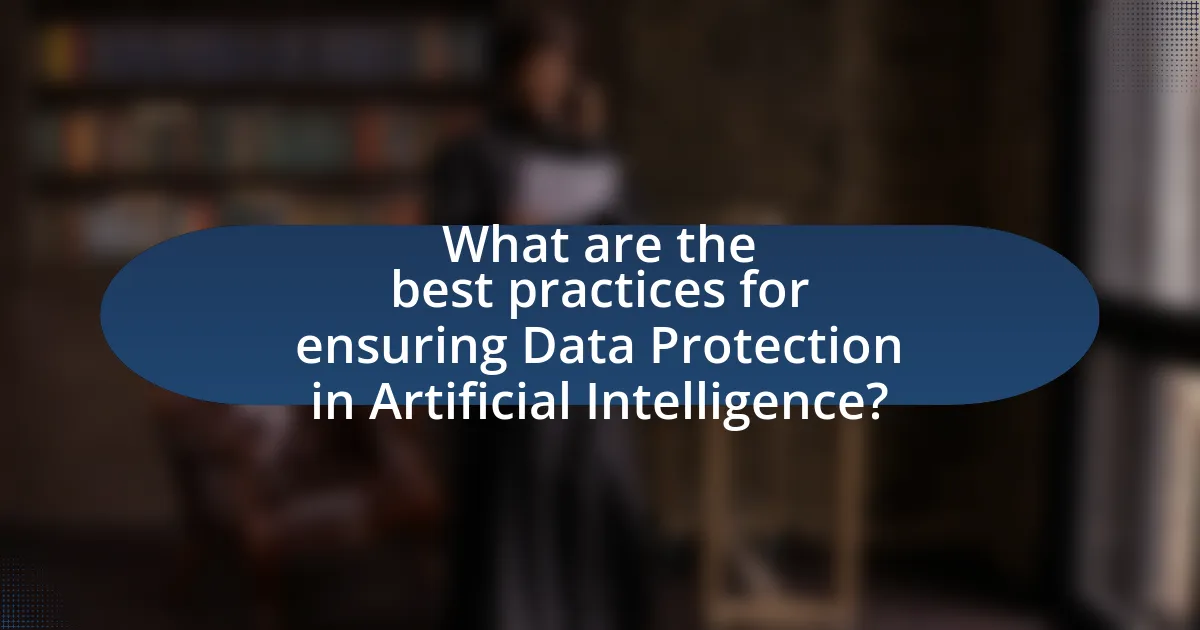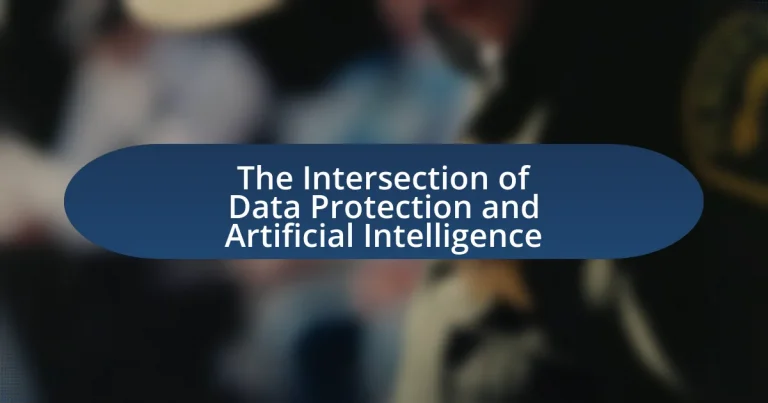The intersection of data protection and artificial intelligence (AI) is a critical area that addresses the balance between leveraging AI technologies for data analysis and ensuring compliance with data privacy regulations. This article explores how AI systems, which often rely on large datasets containing personal information, must adhere to strict guidelines such as the General Data Protection Regulation (GDPR). Key principles of data protection relevant to AI, including data minimization and accountability, are discussed alongside the risks AI poses to data privacy, such as unauthorized access and algorithmic bias. Additionally, the article examines the legal and ethical dilemmas arising from AI’s integration into data protection, the challenges organizations face in compliance, and the best practices for safeguarding personal data in AI applications. Emerging innovations and future trends in data protection and AI are also highlighted, emphasizing the need for robust frameworks to ensure ethical and responsible AI development.

What is the Intersection of Data Protection and Artificial Intelligence?
The intersection of data protection and artificial intelligence (AI) involves the balance between utilizing AI technologies for data analysis and ensuring compliance with data privacy regulations. AI systems often require large datasets, which can include personal information, raising concerns about how this data is collected, processed, and stored. For instance, regulations like the General Data Protection Regulation (GDPR) in Europe mandate strict guidelines on data usage, requiring organizations to implement measures that protect individuals’ privacy while leveraging AI capabilities. This intersection is critical as it shapes how organizations develop AI solutions that respect user privacy and adhere to legal standards, ensuring ethical use of data in AI applications.
How do Data Protection and Artificial Intelligence relate to each other?
Data protection and artificial intelligence (AI) are interconnected as AI systems often rely on large datasets that may contain personal information, necessitating compliance with data protection regulations. The General Data Protection Regulation (GDPR) in Europe, for example, mandates that organizations must ensure the privacy and security of personal data when utilizing AI technologies. This relationship highlights the need for ethical AI development, where data protection principles guide the design and implementation of AI systems to prevent misuse of personal data and ensure transparency in data processing practices.
What are the key principles of data protection relevant to AI?
The key principles of data protection relevant to AI include data minimization, purpose limitation, accuracy, storage limitation, integrity and confidentiality, and accountability. Data minimization mandates that only necessary data for a specific purpose should be collected and processed, reducing the risk of misuse. Purpose limitation ensures that data is collected for legitimate purposes and not used beyond those intentions. Accuracy requires that data be kept up to date and correct, which is crucial for AI systems that rely on high-quality data for decision-making. Storage limitation dictates that personal data should not be retained longer than necessary, mitigating risks associated with data breaches. Integrity and confidentiality emphasize the need for appropriate security measures to protect data from unauthorized access and breaches. Finally, accountability holds organizations responsible for complying with data protection laws and regulations, ensuring transparency in AI operations. These principles are foundational to frameworks like the General Data Protection Regulation (GDPR), which sets stringent guidelines for data handling in AI applications.
How does AI impact data protection regulations?
AI significantly impacts data protection regulations by necessitating updates to existing laws to address the complexities of automated data processing. The introduction of AI technologies raises concerns about data privacy, consent, and the potential for bias in decision-making processes. For instance, the General Data Protection Regulation (GDPR) in the European Union has specific provisions that require organizations to ensure transparency and accountability in AI systems, mandating that individuals have the right to understand how their data is used and processed. Additionally, AI’s ability to analyze vast amounts of personal data can lead to increased scrutiny from regulatory bodies, prompting the need for stricter compliance measures and guidelines to protect individuals’ rights.
Why is the intersection of Data Protection and Artificial Intelligence important?
The intersection of Data Protection and Artificial Intelligence is important because it addresses the ethical and legal implications of using AI technologies that process personal data. As AI systems increasingly rely on vast amounts of data to function effectively, ensuring compliance with data protection regulations, such as the General Data Protection Regulation (GDPR), becomes critical. For instance, GDPR mandates that organizations must obtain explicit consent from individuals before processing their data, which directly impacts how AI models are trained and deployed. Furthermore, the integration of data protection principles into AI development helps mitigate risks related to privacy breaches and discrimination, thereby fostering trust among users and stakeholders.
What risks does AI pose to data privacy?
AI poses significant risks to data privacy, primarily through unauthorized data access, data breaches, and the potential for misuse of personal information. AI systems often require vast amounts of data to function effectively, which can lead to the collection and storage of sensitive information without proper consent or security measures. For instance, a 2020 report by the European Union Agency for Cybersecurity highlighted that AI technologies can inadvertently expose personal data during processing, increasing the likelihood of breaches. Additionally, AI’s ability to analyze and infer information from datasets can lead to the re-identification of anonymized data, further compromising individual privacy.
How can data protection enhance AI systems?
Data protection enhances AI systems by ensuring the integrity, privacy, and security of the data used for training and operation. When AI systems are built on protected data, they are less susceptible to breaches and misuse, which can lead to more reliable and trustworthy outcomes. For instance, implementing data protection measures such as encryption and anonymization can prevent unauthorized access and reduce the risk of bias in AI algorithms, as seen in studies that demonstrate how biased data can lead to skewed AI results. Furthermore, compliance with data protection regulations, like the General Data Protection Regulation (GDPR), fosters consumer trust, encouraging more individuals to share their data for AI development, ultimately improving the quality and effectiveness of AI systems.

What are the challenges at the Intersection of Data Protection and Artificial Intelligence?
The challenges at the intersection of data protection and artificial intelligence include ensuring compliance with privacy regulations, managing data security risks, and addressing algorithmic bias. Compliance with regulations such as the General Data Protection Regulation (GDPR) requires organizations to implement strict data handling practices, which can conflict with the data-intensive nature of AI systems. Additionally, AI systems often rely on large datasets, increasing the risk of data breaches and unauthorized access, which poses significant security challenges. Furthermore, algorithmic bias can lead to unfair treatment of individuals based on sensitive data, raising ethical concerns and potentially violating data protection laws. These challenges necessitate a careful balance between leveraging AI capabilities and safeguarding personal data rights.
What legal and ethical dilemmas arise from AI in data protection?
AI in data protection raises significant legal and ethical dilemmas, primarily concerning privacy, consent, and accountability. The use of AI technologies often involves processing vast amounts of personal data, which can conflict with existing data protection laws such as the General Data Protection Regulation (GDPR) in Europe, which mandates explicit consent for data usage. Furthermore, ethical concerns arise regarding the potential for bias in AI algorithms, leading to discriminatory practices against certain groups. The lack of transparency in AI decision-making processes complicates accountability, making it difficult to determine who is responsible for data breaches or misuse. These dilemmas highlight the need for robust regulatory frameworks that address both the legal and ethical implications of AI in data protection.
How do different jurisdictions approach AI and data protection?
Different jurisdictions approach AI and data protection through varying regulatory frameworks and legal standards. For instance, the European Union implements the General Data Protection Regulation (GDPR), which emphasizes data subject rights and accountability for AI systems processing personal data. In contrast, the United States adopts a sectoral approach, with laws like the California Consumer Privacy Act (CCPA) focusing on consumer rights but lacking a comprehensive federal framework. Additionally, countries like China enforce strict data localization and security measures under the Personal Information Protection Law (PIPL), reflecting a more centralized control over data. These differences illustrate how cultural, legal, and economic factors shape the regulatory landscape for AI and data protection across jurisdictions.
What ethical considerations must be addressed in AI development?
Ethical considerations in AI development include fairness, accountability, transparency, privacy, and security. Fairness ensures that AI systems do not perpetuate biases, which can lead to discrimination against certain groups. Accountability involves establishing clear responsibility for AI decisions, particularly in high-stakes scenarios like healthcare or criminal justice. Transparency requires that AI algorithms and their decision-making processes are understandable to users and stakeholders, fostering trust. Privacy concerns focus on the protection of personal data used in AI training and operation, ensuring compliance with regulations like GDPR. Security addresses the need to protect AI systems from malicious attacks that could compromise their integrity and the data they handle. These considerations are critical to developing responsible AI that aligns with societal values and legal standards.
How do organizations navigate compliance with data protection laws in AI?
Organizations navigate compliance with data protection laws in AI by implementing robust data governance frameworks and conducting regular audits. These frameworks ensure that data collection, processing, and storage practices align with regulations such as the General Data Protection Regulation (GDPR) and the California Consumer Privacy Act (CCPA). For instance, organizations often employ data minimization techniques, ensuring only necessary data is collected, and utilize privacy impact assessments to identify and mitigate risks associated with AI systems. Additionally, training employees on data protection principles and establishing clear data handling policies further supports compliance efforts.
What frameworks exist for ensuring compliance in AI systems?
Several frameworks exist for ensuring compliance in AI systems, including the General Data Protection Regulation (GDPR), the Ethical Guidelines for Trustworthy AI by the European Commission, and the AI Risk Management Framework by the National Institute of Standards and Technology (NIST). The GDPR mandates data protection and privacy for individuals within the European Union, establishing strict guidelines for data processing and user consent. The Ethical Guidelines for Trustworthy AI emphasize principles such as transparency, accountability, and fairness in AI development and deployment. The NIST AI Risk Management Framework provides a structured approach to managing risks associated with AI technologies, promoting safety and effectiveness. These frameworks collectively guide organizations in aligning their AI systems with legal and ethical standards, ensuring compliance and fostering public trust.
How can organizations implement best practices for data protection in AI?
Organizations can implement best practices for data protection in AI by adopting a comprehensive data governance framework that includes data minimization, encryption, access controls, and regular audits. Data minimization ensures that only necessary data is collected and processed, reducing exposure to breaches. Encryption protects data at rest and in transit, making it unreadable to unauthorized users. Access controls limit data access to authorized personnel only, thereby reducing the risk of insider threats. Regular audits help identify vulnerabilities and ensure compliance with data protection regulations, such as GDPR, which mandates strict data handling practices. These measures collectively enhance the security and integrity of data used in AI systems.

What are the best practices for ensuring Data Protection in Artificial Intelligence?
The best practices for ensuring data protection in artificial intelligence include implementing data minimization, ensuring transparency, and utilizing robust encryption methods. Data minimization involves collecting only the necessary data for AI models, which reduces exposure to potential breaches. Transparency requires organizations to inform users about data collection and usage, fostering trust and compliance with regulations like GDPR. Robust encryption methods protect data both at rest and in transit, making it difficult for unauthorized parties to access sensitive information. These practices are essential for safeguarding personal data and maintaining compliance with legal standards in AI applications.
How can organizations effectively manage data privacy in AI projects?
Organizations can effectively manage data privacy in AI projects by implementing robust data governance frameworks that prioritize transparency, consent, and security. Establishing clear policies for data collection, usage, and sharing ensures compliance with regulations such as GDPR, which mandates that organizations must obtain explicit consent from individuals before processing their personal data. Additionally, employing techniques like data anonymization and encryption can protect sensitive information while still allowing for valuable insights to be derived from AI models. Regular audits and assessments of data handling practices further reinforce accountability and help identify potential vulnerabilities, thereby enhancing overall data privacy management.
What role does transparency play in AI and data protection?
Transparency is crucial in AI and data protection as it fosters trust and accountability in the use of algorithms and data handling practices. By clearly communicating how AI systems operate and how data is collected, processed, and utilized, organizations can mitigate risks associated with data misuse and enhance user confidence. For instance, the General Data Protection Regulation (GDPR) emphasizes the importance of transparency, requiring organizations to inform individuals about their data processing activities, thereby ensuring compliance and protecting user rights. This regulatory framework illustrates that transparency not only supports ethical AI practices but also aligns with legal obligations, reinforcing the necessity of clear communication in the intersection of AI and data protection.
How can organizations conduct risk assessments for AI systems?
Organizations can conduct risk assessments for AI systems by systematically identifying potential risks, evaluating their impact, and implementing mitigation strategies. This process typically involves several key steps: defining the scope of the AI system, identifying data inputs and outputs, assessing the potential for bias and discrimination, evaluating compliance with data protection regulations, and analyzing the security of the system against vulnerabilities.
For instance, the European Union’s General Data Protection Regulation (GDPR) mandates that organizations assess the risks associated with data processing activities, including those involving AI, to ensure compliance and protect individuals’ rights. Additionally, frameworks such as the NIST AI Risk Management Framework provide structured guidelines for organizations to evaluate risks associated with AI technologies, emphasizing the importance of transparency, accountability, and ethical considerations in the assessment process.
What tools and technologies can support data protection in AI?
Data protection in AI can be supported by tools and technologies such as encryption, access controls, anonymization techniques, and secure data storage solutions. Encryption ensures that data is unreadable without the correct decryption key, protecting sensitive information from unauthorized access. Access controls limit who can view or manipulate data, thereby reducing the risk of data breaches. Anonymization techniques, such as data masking and differential privacy, help to protect individual identities within datasets, making it difficult to trace data back to specific individuals. Secure data storage solutions, including cloud services with built-in security features, provide a safe environment for storing sensitive information. These technologies collectively enhance data protection by mitigating risks associated with data handling in AI applications.
What are the most effective data anonymization techniques for AI?
The most effective data anonymization techniques for AI include differential privacy, k-anonymity, and data masking. Differential privacy ensures that the output of a database query does not reveal too much information about any individual in the dataset, making it a robust method for protecting individual privacy while still allowing for data analysis. K-anonymity involves modifying the dataset so that each individual cannot be distinguished from at least k-1 other individuals, thus providing a layer of anonymity. Data masking replaces sensitive data with non-sensitive equivalents, allowing for the use of data in development and testing without exposing real information. These techniques are widely recognized in the field of data protection and have been validated through various studies, demonstrating their effectiveness in safeguarding personal information while enabling AI applications.
How can machine learning algorithms be designed to respect data privacy?
Machine learning algorithms can be designed to respect data privacy by implementing techniques such as differential privacy, federated learning, and data anonymization. Differential privacy adds noise to the data or the results of queries, ensuring that individual data points cannot be identified, thus protecting user privacy. Federated learning allows models to be trained across decentralized devices without transferring raw data to a central server, which minimizes exposure of sensitive information. Data anonymization techniques, such as k-anonymity, ensure that data cannot be traced back to individuals by removing or generalizing identifiable information. These methods have been validated in various studies, demonstrating their effectiveness in maintaining privacy while still enabling the utility of machine learning models.
What are the future trends in Data Protection and Artificial Intelligence?
Future trends in Data Protection and Artificial Intelligence include increased regulatory frameworks, enhanced privacy-preserving techniques, and the integration of AI in data governance. Regulatory frameworks, such as the General Data Protection Regulation (GDPR) and emerging laws worldwide, are shaping how organizations handle personal data, emphasizing accountability and transparency. Enhanced privacy-preserving techniques, like federated learning and differential privacy, are being developed to allow AI models to learn from data without compromising individual privacy. Additionally, AI is increasingly being utilized in data governance to automate compliance checks and risk assessments, improving efficiency and accuracy in data protection practices. These trends reflect a growing recognition of the need to balance innovation in AI with robust data protection measures.
How might evolving regulations shape AI development?
Evolving regulations will significantly shape AI development by establishing frameworks that govern data usage, ethical considerations, and accountability. These regulations, such as the General Data Protection Regulation (GDPR) in Europe, mandate transparency in AI algorithms and require organizations to implement data protection measures, thereby influencing how AI systems are designed and deployed. For instance, compliance with GDPR has led companies to prioritize privacy by design, which affects the architecture of AI models and the data they utilize. As regulations continue to evolve, they will likely drive innovation in AI technologies that align with legal standards, ensuring that AI development is responsible and respects user rights.
What innovations are emerging to enhance data protection in AI?
Emerging innovations to enhance data protection in AI include federated learning, differential privacy, and homomorphic encryption. Federated learning allows models to be trained across decentralized devices without sharing raw data, thus preserving user privacy. Differential privacy adds noise to datasets, ensuring that individual data points cannot be easily identified, which has been adopted by major tech companies like Apple and Google to protect user information. Homomorphic encryption enables computations on encrypted data, allowing AI models to analyze data without ever exposing it, thereby maintaining confidentiality. These innovations collectively address the growing concerns around data security and privacy in AI applications.





